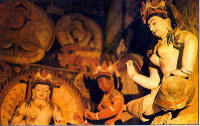|
LAHUL SPITI, the land of
monasteries and mysteries of gods and deities is the divine gift of
nature on earth. The snow capped Himalayas present a panoramic
pageantry of exquisite creations of nature. Located in the dizzy
height of the Himalayas with passes that  remain closed for
six months, Lahul and Spiti were till now a forbidden land. Now this
area has been opened to the adventurous people who can have a
glimpse of the magnificent valley;The world famous
ancient monastery located on the bank of river Spiti
offers a valuable window to Tibetan culture: Art and
architecture here are as stupendous as in Ajanta caves, The monastic
complex consisting of nine Shrines was constructed and
renovated between 10 th & l5th century and an inner chapel
suggests its foundation in 996 AD. The most important amongst these
shrine is Dukhung. Here 33 stucco images of Buddha.
Bodhisatvas gods and goddess surround the central. figure of
Vairochana. Every inch of the wall is embellished with beautiful
paintings which are as old as the monastery. The life of Sakyamuni
Buddlha is also elegantly depicted here. The gompa also
contains wooden images and a precious library of
manuscripts. Tabo was built before Alchi monastery of LadaKh,
nevertheless, both of them contain huge repository of contemporary
Kashmiri art of the 11 th century. It also bridges missing links
between artistic styles of India and Tibet. The soft and tender
expression of the figures are the conspicuous influence of
Ajanta. remain closed for
six months, Lahul and Spiti were till now a forbidden land. Now this
area has been opened to the adventurous people who can have a
glimpse of the magnificent valley;The world famous
ancient monastery located on the bank of river Spiti
offers a valuable window to Tibetan culture: Art and
architecture here are as stupendous as in Ajanta caves, The monastic
complex consisting of nine Shrines was constructed and
renovated between 10 th & l5th century and an inner chapel
suggests its foundation in 996 AD. The most important amongst these
shrine is Dukhung. Here 33 stucco images of Buddha.
Bodhisatvas gods and goddess surround the central. figure of
Vairochana. Every inch of the wall is embellished with beautiful
paintings which are as old as the monastery. The life of Sakyamuni
Buddlha is also elegantly depicted here. The gompa also
contains wooden images and a precious library of
manuscripts. Tabo was built before Alchi monastery of LadaKh,
nevertheless, both of them contain huge repository of contemporary
Kashmiri art of the 11 th century. It also bridges missing links
between artistic styles of India and Tibet. The soft and tender
expression of the figures are the conspicuous influence of
Ajanta.
|
 |
|
|
 Tabo is one of the
few monuments where one can study continuous development of Western
Tibetan art from 11th to 2Oth centuries. It goes to the credit of
the Archaeological Survey of India, which has been deputing its team
of experts year after year to undertake the challenging task of
conservation of the historical monument.Some scholars are of the
view that some of the murals of Tabo monastery are as old as the
monastery itself. Others offering a conservating estimate date the
wall paintings to 5QO years back. The Tabo complex
is surrounded on all the four sides by a high mud wall. Of nine
structures, all single storied, the biggest the oldest and the
finest is one called Duwang Lakhang. In this structure, the spacious
chaitya (hall) is used by monks for daily prayers. There is no
window but a small image of the four-faced Buddha Vairochana is a
magnificent idol and represents dharma: chakra-pravartan mudra. Behind the
statue is a figure of Amitay Buddha seated in the innermost sanctum. Tabo is one of the
few monuments where one can study continuous development of Western
Tibetan art from 11th to 2Oth centuries. It goes to the credit of
the Archaeological Survey of India, which has been deputing its team
of experts year after year to undertake the challenging task of
conservation of the historical monument.Some scholars are of the
view that some of the murals of Tabo monastery are as old as the
monastery itself. Others offering a conservating estimate date the
wall paintings to 5QO years back. The Tabo complex
is surrounded on all the four sides by a high mud wall. Of nine
structures, all single storied, the biggest the oldest and the
finest is one called Duwang Lakhang. In this structure, the spacious
chaitya (hall) is used by monks for daily prayers. There is no
window but a small image of the four-faced Buddha Vairochana is a
magnificent idol and represents dharma: chakra-pravartan mudra. Behind the
statue is a figure of Amitay Buddha seated in the innermost sanctum.
Of the stucco idols, one very
magnificent is of bodhisatva Maitreya seated on a high
lotus seat. The 5.21 metre high
image represent future Buddha in paryanka sasana and in
dharma-chakra-pravartan mudra . The curly hair on the head is an
indication of the influence of the Gupta period.
In the open courtyard around the built-up edifices, are seen
a number of stupas, which have been raised to house the sacred ashes
(mortal remains) of the Lamas who breathed their last while staying
in this holy place.
The Tabo Monastery is a real trove of
Buddhist Himalayan art and has happily escaped ravages of time and
the onslaught of invaders and iconoclasts. It is a magnificent
heritage with immense potential awaiting
exposure in the the time to come. By S. Bhardwaj
150696
indiane xpress | 
